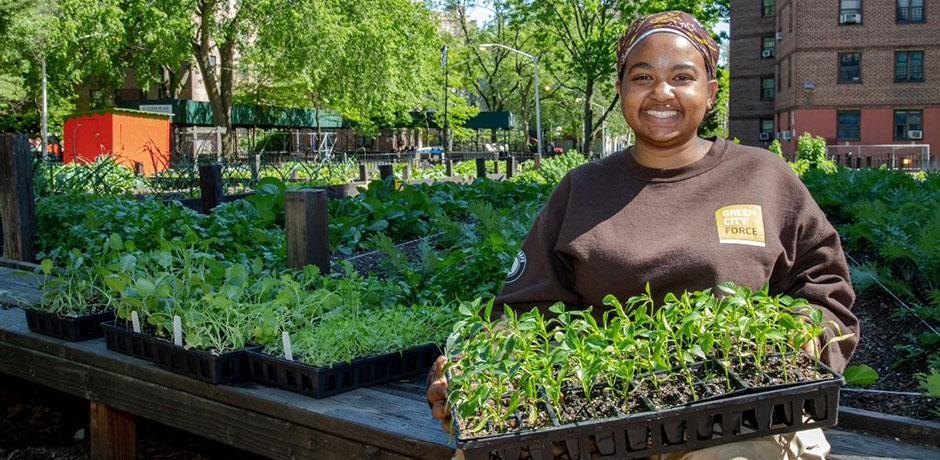The 8-Minute Rule for City Blooming
The 8-Minute Rule for City Blooming
Blog Article
A Biased View of City Blooming
Table of Contents5 Simple Techniques For City BloomingThe Ultimate Guide To City BloomingThe Of City BloomingThe smart Trick of City Blooming That Nobody is DiscussingThe smart Trick of City Blooming That Nobody is Talking About
Intrigued in growing food to buy in the City of Chicago? Thinking of beginning a neighborhood garden? Changes to the Chicago Zoning Statute allow agricultural usages like community yards and urban ranches in lots of parts of the city. Below is a listing of regularly asked questions relating to the regulations and policies that cultivators need to take into consideration when planning a metropolitan farming task.
The zoning amendment does not change any kind of other codes taking care of composting, structure licenses, acquiring or renting City had building, business licenses or ecological contamination. There are existing codes that manage these issues and they continue to be in complete effect and might be relevant to your task. Community gardens are typically owned or handled by public entities, public companies or community-based companies and preserved by volunteers.
Urban farms grow food that is planned to be marketed, either on a not-for-profit or for-profit basis. Due to their industrial purpose, city farms need an organization permit. Yes. An area garden is permitted to market excess create that was grown on site if the sales are accessory or subordinate to the garden's primary purpose explained above.
The Of City Blooming
Composting is permitted but just for plant material that is produced and used on website. The amount of garden compost product can not go beyond 25 cubic yards at any kind of given time according to the standards in 7-28-715 of the City's Municipal Code. Yes. Due to the fact that the dirt at many brand-new garden sites requires amending, compost, dirt, wood chips, or various other materials can be gotten to construct or improve the expanding room - City gardening.

If a building permit is required then the hoophouse will be taken into consideration an accessory structure. You can discover more about the structure license needs by contacting the Department of Structures. The 25,000-square-foot size restriction is planned to stop a solitary area yard from controling a provided block or taking away from the block's existing property or business character.
The limitation does not apply to gardens found in Public Open Area (POS) districts. Can there be even more than one neighborhood garden that is 25,000 square feet on a solitary block? Secure fencing is not needed, however, yards that have large vehicle parking areas may be needed to install fence or other landscape design functions.
City Blooming - The Facts
B1 & B2 districts need that all commercial usage activities be performed indoors. Is fence required for metropolitan ranches? Fences might be needed, along with landscape design and testing, for particular vehicle parking areas and outside job or storage space areas depending on location and the specific activity taking location.
Yes. Urban farms need building licenses and zoning approvals before building and construction. Other forms of city evaluation might be required depending on particular frameworks, activities, dimension, landscaping, licensing, public health and stormwater administration concerns. Much of these demands are recognized in the project design or permitting process, nevertheless, the candidate may be responsible to individually identify details licenses or permits that may be needed.
Yes. The kind of permit is established by what is happening at the site. The Division of Company Affairs and Customer Protection can help establish the particular sort of service certificate that's required. Yes. Off street car parking is needed for most business projects in Chicago. The called for number of garage is based on the variety of workers working on site and not the square video footage of the expanding space.
The smart Trick of City Blooming That Nobody is Talking About

An urban ranch can market garden compost product produced on website, nonetheless, the procedure needs to abide with the regulations in 7-28-715 of the Chicago Municipal Code. Aquaponic systems are permitted indoors on urban farms in numerous zoning districts.
As much as five hives or colonies of honey bees may be kept as an accessory use. Beekeepers need to sign up with the Illinois Department of Agriculture. For additional information about the recommended zoning modification you may contact the Department of Housing and Economic Growth, Bureau of Planning and Zoning at 312.744.8563.
, which takes place in country locations at the edge of suburbs.
10 Easy Facts About City Blooming Described
It can involve a movement of natural Go Here growers, "foodies" and "locavores", who seek to create social media networks based on a common ethos of nature and neighborhood holism. These networks can create using formal institutional assistance, becoming incorporated into regional community planning as a "change town" motion for lasting metropolitan advancement.
Some of the initial evidence of urban agriculture comes from Mesopotamia.
Report this page